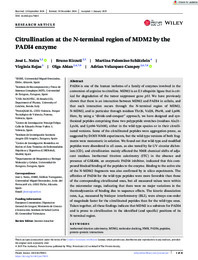Por favor, use este identificador para citar o enlazar este ítem:
https://hdl.handle.net/11000/37789Registro completo de metadatos
| Campo DC | Valor | Lengua/Idioma |
|---|---|---|
| dc.contributor.author | Neira, José L. | - |
| dc.contributor.author | Rizzuti, Bruno | - |
| dc.contributor.author | Palomino-Schätzlein, Martina | - |
| dc.contributor.author | Rejas, Virginia | - |
| dc.contributor.author | Abian, Olga | - |
| dc.contributor.author | Velazquez-Campoy, Adrian | - |
| dc.contributor.other | Departamentos de la UMH::Agroquímica y Medio Ambiente | es_ES |
| dc.date.accessioned | 2025-11-03T12:23:23Z | - |
| dc.date.available | 2025-11-03T12:23:23Z | - |
| dc.date.created | 2025 | - |
| dc.identifier.citation | Protein Science | es_ES |
| dc.identifier.issn | 1469-896X | - |
| dc.identifier.issn | 0961-8368 | - |
| dc.identifier.uri | https://hdl.handle.net/11000/37789 | - |
| dc.description.abstract | PADI4 is one of the human isoforms of a family of enzymes involved in the conversion of arginine to citrulline. MDM2 is an E3 ubiquitin ligase that is critical for degradation of the tumor suppressor gene p53. We have previously shown that there is an interaction between MDM2 and PADI4 in cellulo, and that such interaction occurs through the N-terminal region of MDM2, N-MDM2, and in particular through residues Thr26, Val28, Phe91, and Lys98. Here, by using a “divide-and-conquer” approach, we have designed and synthesized peptides comprising these two polypeptide stretches (residues Ala21–Lys36, and Lys94–Val108), either in the wild-type species or in their citrullinated versions. Some of the citrullinated peptides were aggregation-prone, as suggested by DOSY-NMR experiments, but the wild-type versions of both fragments were monomeric in solution. We found out that wild-type and modified peptides were disordered in all cases, as also tested by far-UV circular dichroism (CD), and citrullination mainly affected the NMR chemical shifts of adjacent residues. Isothermal titration calorimetry (ITC) in the absence and presence of GSK484, an enzymatic PADI4 inhibitor, indicated that this compound blocked binding of the peptides to the enzyme. Binding to the active site of the N-MDM2 fragments was also confirmed by in silico experiments. The affinities of PADI4 for the wild-type peptides were more favorable than those of the corresponding citrullinated ones, but all measured values were within the micromolar range, indicating that there were no major variations in the thermodynamics of binding due to sequence effects. The kinetic dissociation rates, koff, measured by biolayer interferometry (BLI), were always one-order of magnitude faster for the citrullinated peptides than for the wild-type ones. Taken together, all these findings indicate that MDM2 is a substrate for PADI4 and is prone to citrullination in the identified (and specific) positions of its N-terminal region. | es_ES |
| dc.format | application/pdf | es_ES |
| dc.format.extent | 21 | es_ES |
| dc.language.iso | eng | es_ES |
| dc.publisher | Wiley | es_ES |
| dc.relation.ispartofseries | 34 | es_ES |
| dc.relation.ispartofseries | 2 | es_ES |
| dc.rights | info:eu-repo/semantics/openAccess | es_ES |
| dc.rights | Attribution-NonCommercial-NoDerivatives 4.0 Internacional | * |
| dc.rights.uri | http://creativecommons.org/licenses/by-nc-nd/4.0/ | * |
| dc.subject | Isothermal titration calorimetry | es_ES |
| dc.subject | MDM2 | es_ES |
| dc.subject | Molecular docking | es_ES |
| dc.subject | NMR | es_ES |
| dc.subject | PADI4 | es_ES |
| dc.subject | Peptides | es_ES |
| dc.subject | Protein–protein interactions | es_ES |
| dc.subject.other | CDU::5 - Ciencias puras y naturales | es_ES |
| dc.title | Citrullination at the N-terminal region of MDM2 by the PADI4 enzyme | es_ES |
| dc.type | info:eu-repo/semantics/article | es_ES |
| dc.relation.publisherversion | https://doi.org/10.1002/pro.70033 | es_ES |

Ver/Abrir:
Protein Science2025.pdf
3,03 MB
Adobe PDF
Compartir:
 La licencia se describe como: Atribución-NonComercial-NoDerivada 4.0 Internacional.
La licencia se describe como: Atribución-NonComercial-NoDerivada 4.0 Internacional.
.png)